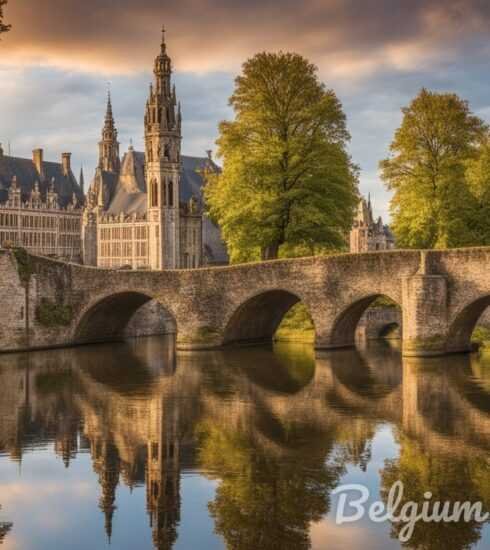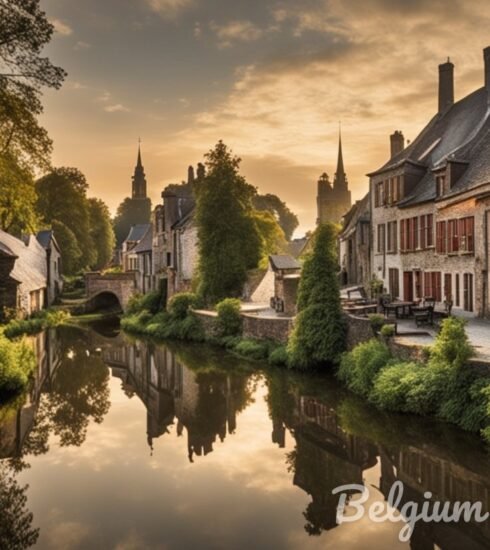Discover Belgium Heritage Stories: Unearthing Hidden Tales of Time
Echoes of Time: Unearthing Belgium’s Hidden Heritage through Untold Tales
Belgium, a country rich in history and culture, offers an extraordinary array of heritage stories that are yet to be fully uncovered. From its medieval towns and Renaissance architecture to the battlefields of World War I and II, the belgium heritage stories weave a tapestry that captures the imagination of historians, tourists, and locals alike.
As we delve deeper into Belgium’s hidden treasures, we discover tales that not only tell us about the past but also connect us to the present.
Historical Context of Belgium’s Heritage
Belgium’s position at the crossroads of Europe has made it a melting pot of cultures, ideologies, and histories. The country has experienced significant influences from the Roman Empire, the Holy Roman Empire, and numerous other European powers. This rich background has crafted a landscape dotted with historical landmarks that echo its tumultuous past.
The Roman Influence
The Roman Empire’s expansion into what is now Belgium laid a foundation that would shape the region for centuries. Cities like Tongeren, formerly known as Atuatuca Tongroensis, served as important military and trade centers. Notably, the Roman ruins in this area remain one of the Belgium heritage stories that attract history enthusiasts from around the globe.
- Archaeological sites: The interactive Museum of the Roman Age provides a glimpse into this ancient civilization.
- Historical significance: Understanding Roman influence helps illuminate the development of subsequent Belgian culture.
The Medieval Era
The rise of the feudal system during the medieval ages introduced a series of castles and fortified towns. Places like Bruges and Ghent provide striking examples of this period through their architecture and urban planning. Moreover, the construction of the Belfries, which served as both watchtowers and clock towers, is a significant aspect of belgium heritage stories that reveals the socio-political dynamics of the time.
Uncovering Belgium’s Untold Tales
Amidst the well-known landmarks, there exist lesser-known stories that define the character of this nation. From forgotten monuments to the lives of common citizens during pivotal historical moments, exploring these narratives enriches our understanding of Belgian heritage.
The Battlefields of World War I
Belgium’s role in World War I is a poignant chapter in its history, with battlefields such as Flanders Fields becoming synonymous with sacrifice and remembrance. The site encapsulates the stories of countless soldiers, and the “In Flanders Fields Museum” serves to educate future generations about the impact of the Great War.
- Visitor statistics: The museum sees over 200,000 visitors annually, emphasizing its importance as a historical site.
- Commemoration: Events held in July and November continuously honor those who fought and died.
The Hidden Neolithic Heritage
Recently, archaeologists have unearthed evidence of Neolithic settlements in Belgium, revealing that this region was populated long before recorded history. Findings near the Meuse River demonstrate the advanced agricultural practices of these early communities. These discoveries form part of Belgium’s heritage stories, illustrating the longstanding connection of its people to the land.
Key Historic Landmarks in Belgium

As we explore the physical manifestations of Belgium’s rich history, we encounter numerous historic landmarks that stand as testaments to its heritage. Each landmark is a story waiting to be told, offering insights into the lives and eras that shaped modern Belgium.
Grand Place, Brussels
The Grand Place, or Grote Markt, is Brussels’ central square, characterized by opulent guildhalls and the Town Hall. Designated a UNESCO World Heritage site in 1998, the square’s rich history from the 12th century to the present is a crucial component of Belgium’s heritage stories.
- Architecture: A mix of Gothic, Baroque, and Louis XIV styles, it reflects the wealth of the city during the 17th century.
- Events: The Flower Carpet, held every two years, transforms the square into a floral masterpiece, attracting tourists worldwide.
Castles of Belgium
Beneath the rolling hills of Belgium lies a treasure trove of castles, each with its own story. The Gravensteen Castle in Ghent, built in 1180, showcases medieval architecture and offers an intriguing insight into the country’s feudal past. Exploring these fortresses not only adds depth to belgium heritage stories but also fosters an appreciation for Belgium’s architectural diversity.
Cultural Significance of Heritage Preservation
Preserving Belgium’s hidden heritage is crucial for numerous reasons. Not only does it foster a sense of identity and continuity, but it also enhances cultural tourism and provides educational opportunities for future generations. By recognizing and valuing belgium heritage stories, we ensure that the lessons learned from the past do not fade with time.
Education and Awareness
Through educational programs and public awareness campaigns, organizations are beginning to highlight the importance of preserving Belgium’s intangible cultural heritage. Schools often incorporate local history into their curriculums, encouraging students to engage with their heritage actively.
Tourism and Economic Impact
Tourism directly benefits from heritage preservation, as preserved sites attract visitors both nationally and internationally. The economic impact is substantial:
- Visitor spending: Heritage tourism contributes millions to the local economy.
- Job creation: Increased tourist activity leads to job opportunities in hospitality, guide services, and conservation efforts.
The historic cities of Bruges and Antwerp, known for their unique architecture and vibrant culture, thrive on such heritage tourism.
The Role of Technology in Heritage Preservation
The advent of technology has revolutionized how we preserve and encounter heritage stories. With advances in digital archiving, 3D modeling, and virtual reality, it is now possible to experience history in unprecedented ways.
Digital Archives and Online Access

Institutions are increasingly turning to digital archives to preserve historical documents and artifacts. This allows wider public access to Belgium’s heritage stories without geographical limitations:
- Online exhibitions: Museums like the Royal Museums of Fine Arts of Belgium offer virtual tours that bring art history to life.
- Social media engagement: Platforms like Instagram and Twitter help disseminate information and collect stories from the public.
Virtual Reality and Augmented Reality
Technological innovations like VR and AR tools are being employed to create immersive experiences for visitors. Imagine stepping into a digitally reconstructed medieval town or participating in virtual reenactments of significant historical events. These experiences enhance empathy and understanding, making history come alive.
Case Studies: Successful Heritage Projects
Various projects across Belgium exemplify the successful blending of heritage preservation and tourism, each contributing to the narrative of belgium heritage stories.
Hanseatic City of Bruges
Bruges, known for its canals, cobblestone streets, and medieval buildings, was recently incorporated into the Hanseatic League Heritage project. This initiative aimed to restore and maintain the historical significance of the city while promoting tourism.
- Outcomes: Increased funding for restoration projects, improved visitor engagement, and expanded educational programs.
- Visitor experience: Guided tours emphasizing the Hanseatic trade routes have become popular, allowing visitors to grasp the economic importance of Bruges in the past.
The Battlefields of Flanders
Commemorations and visitor education surrounding the Flanders battlefields have become a crucial part of Belgium’s heritage preservation. The integration of local communities in these initiatives has fostered a sense of ownership and responsibility among citizens.
- Joint projects: Numerous organizations work together to maintain memorials and promote events that honor the fallen.
- Impact: The area sees a significant number of annual visitors, contributing to the local economy and tourism sector while preserving history.
Challenges in Heritage Preservation
Despite the advancements made in preserving Belgium’s heritage, challenges persist. Issues such as funding, urban development, and shifting cultural priorities threaten the existence of historic landmarks and narratives.
Funding and Resources
Limited government funding for heritage conservation often poses a challenge in maintaining historic sites. This has led to reliance on grants, donations, and local community involvement:
- Impact of funding cuts: Many small museums and heritage sites face closure, risking the loss of valuable narratives.
- Community initiatives: Grassroots movements have emerged, seeking to fundraise and preserve local heritage.

Urban Development Pressures
In urban areas, the push for modernization often conflicts with the need to preserve historical landscapes. New constructions may overshadow old landmarks, leading to a loss of historical context. This dilemma calls for balanced urban planning that respects the historical narrative.
Community Engagement and Local Narratives
One of the most effective ways to preserve Belgium’s heritage is through community involvement. Engaging local citizens in uncovering and sharing their stories can enrich the cultural narrative and instill pride in the heritage.
Grassroots Movements and Local Histories
Community-led projects allow individuals to tell their untold stories, connecting them to the larger tapestry of belgium heritage stories. Programs that facilitate oral history projects can capture the personal experiences of older generations, ensuring that these narratives are not forgotten.
Educational Programs and Workshops
Schools and local organizations may host workshops that teach about local history and heritage preservation. These initiatives serve two purposes:
- Empowerment: They empower residents to take responsibility for their heritage.
- Awareness: They increase awareness and appreciation for local history among younger generations.
The Future of Belgium’s Heritage
As Belgium continues to evolve, so too does its approach to heritage preservation. Moving forward, it is essential to embrace both modern techniques and traditional narratives to safeguard belgium heritage stories for generations to come.
Innovative Approaches to Preservation
Collaboration between the public and private sectors is vital to ensure the sustainability of heritage projects. Initiatives that encourage public participation and investment can lead to innovative solutions for preserving historical sites.
Technological Integration
By embracing technology, heritage sites can enhance visitor engagement and education, paving the way for a vibrant future where history and modernity coexist. This integration will be critical in attracting a new generation interested in their heritage.
Conclusion
Belgium’s hidden heritage and belgium heritage stories are a testament to its complex and rich past. By embracing community engagement, technological advancements, and innovative preservation strategies, the nation can continue to tell its stories for years to come.






